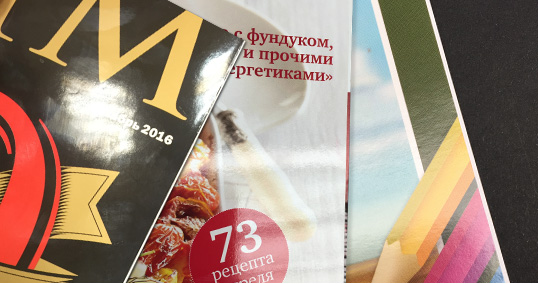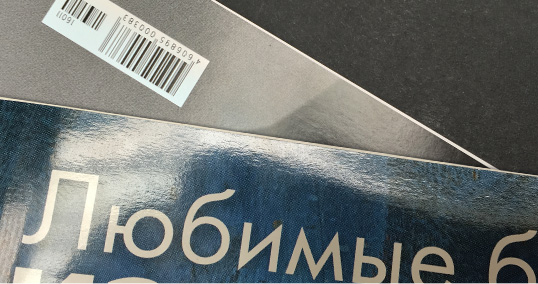HOW DRYING ABILITY OF DIFFERENT TYPES OF PAPER AFFECTS THE CHANGE IN SIZE OF MAGAZINE ELEMENTS DURING STORAGE AND USE
In magazine printing industry, it is not rare that the block and the cover are printed on different types of paper and by different technologies.


Naturally, this leads to various problems, both at printing and the subsequent binding and use of magazines. We are not discussing the processes of prepress and printing here. Let us consider the most frequent phenomenon that occurs at and after the production use and storage of the finished magazines.
This phenomenon is present both in the magazines produced by perfect stitching and wire saddle stitching and means that during the use or storage of magazines the width of the dimensions of edition block increases, wherein the size of the cover remains unchanged. As a result, the block excesses by 0.5-2 mm from under the cover on the front margin. And due to the fact that usually the color of the cover and the first block column are different, it worsens the appearance of the edition and makes the art directors and editors to be dissatisfied and regret over the “wasted years”.
The process of binding ends by trimming of the stitched or bonded edition on three sides. It is conducted on the three-knife trimmer, wherein the cover and the block are cut into one size – in one run, therefore, the block size cannot be physically different from the block size. The size of the block or cover is changed at the equilibrium stabilization by hydrogenation during storage or use in a changed humidity. The “front cut” effect is directly related to the water capacity and absorbency of paper, or rather, a difference in these indicators used for cover and block.
The fact is that paper is hygroscopic, and at moisture changes it tends to level the inner humidity with the ambient humidity. The maximum possible amount of water that paper can absorb is the physical meaning of water capacity indicator of paper. The greater the water capacity of paper, the more water it can absorb from the air. However, the absorption of water is accompanied by an increase in the dimensions of the paper sheet. The largest increase occurs in the transverse direction (perpendicular to the sheet formation direction). Here it is necessary to recall that the main component of paper is cellulose, and at the sheet formation, the cellulose macromolecules are placed in the direction of the sheet movement in the so-called machine direction. If moisture gets in paper, the water molecules push the cellulose macromolecules, causing partial destruction of the intermolecular hydrogen bonds, and this is the cause of the dominant increase in the dimensions of paper in the transverse direction.
Example
In the manufacture of magazines, the paper with different absorbency rates is used for the block. In the magazine “Dom 2”, the cover is printed on fine paper Galerie Art Gloss 130 gsm, with double glossy coating and an improved ratio of whiteness/opacity, absorbency by Cobb 10 29 g/m2, bulk 0.76 cm3/g. The blade-coated paper Galerie Brite 60 gsm, supercalendered, with high whiteness, absorbency by Cobb 10 58 g/m2, bulk 0.86 cm3/g is used for the block. The water capacity of paper Galerie Brite is more than two times greater than that of paper Galerie Art.
SO HOW WATER CAPACITY IS CONNECTED WITH THE VALUE OF LINEAR PAPER DEFORMATION?
The value of the linear longitudinal deformation when paper gets wet has an exponential dependence on the amount of absorbed water. At the internal humidity range from 0 to 60%, this ratio is almost linear. Manufacture, transport and use of the magazines are performed in the range from 10 to 80%. Theoretically calculations of possible deferents of paper sheets sizes at changing paper humidity from 15 to 70% with bringing them to A4 format give the values for the above-mentioned types of paper 0.9 and 1.86 mm respectively. However, in practice, the difference in the linear sizes of the block and cover sometimes reaches up to 2 mm.

In practice, the measurement of deferents for blocks and covers of various magazines revealed an interesting fact – the deferent of the block dimensions coincides with the calculated values, but the theoretical calculations for covers have not been confirmed. The dimensions of the covers of the most publications remain virtually unchanged at the humid environmental conditions change. It turned out that there are still a number of factors affecting the processes of equilibrium paper stabilization by hydrogenation.
THE GEOMETRICAL HYDRODEFERENT OF PAPER IS HIGHLY AFFECTED
BY THE TYPE OF DRYING APPLIED AT PRINTING
The block is usually printed on the web press with hot air dryer, and the cover – on the sheet fed press without hot air dryer. In the hot air dryer, the printed paper is heated to over 170 degrees temperature, and volumetric water evaporation occurs. If the roll paper humidity is of about 50%, after hot air drying the residual moisture of the paper is 5-10%. At further operations on the printing press, the humidity is raised to 15-20% by forced moisturizing of the paper surface with special emulsions. At moisturizing of paper during printing by more than 20%, there is a high anisotropic longitudinal distortion of the paper surface. At printing of the cover, the thermal drying is not applied. The paper on the acceptance of the sheet-fed presses has an equilibrium moisture content of 30–50%, and the climatic conditions in the sheet shops are ideal. According to many experts, the difference between the humidity of the cover and block paper is the second leading cause of the “front cut” effect (the first reason is the difference in water capacity).
BUT THERE ARE OTHER AFFECTING FACTORS
Surface coverage
Affecting the period of equilibrium paper stabilization by hydrogenation. The higher the percentage of coverage, the higher the value of hydrogenation deferent.
UV-coating and lamination
Significantly reduces the effect of humidity changes on the dimensions of cover or insert. However, these finishing operations on some elements of magazines result in the vivid “front cut” effect.
Conclusions: the “front cut” effect refers to the physical and chemical manifestations of the paper properties, and it is not a defect of the printing production. Of course, there are some methods to minimize it, and they logically result from the physical and chemical processes described above, but in most cases, they are unacceptable for the journal production.
